2008.5 Citroen JUMPER DAG wheel
[x] Cancel search: wheelPage 75 of 163
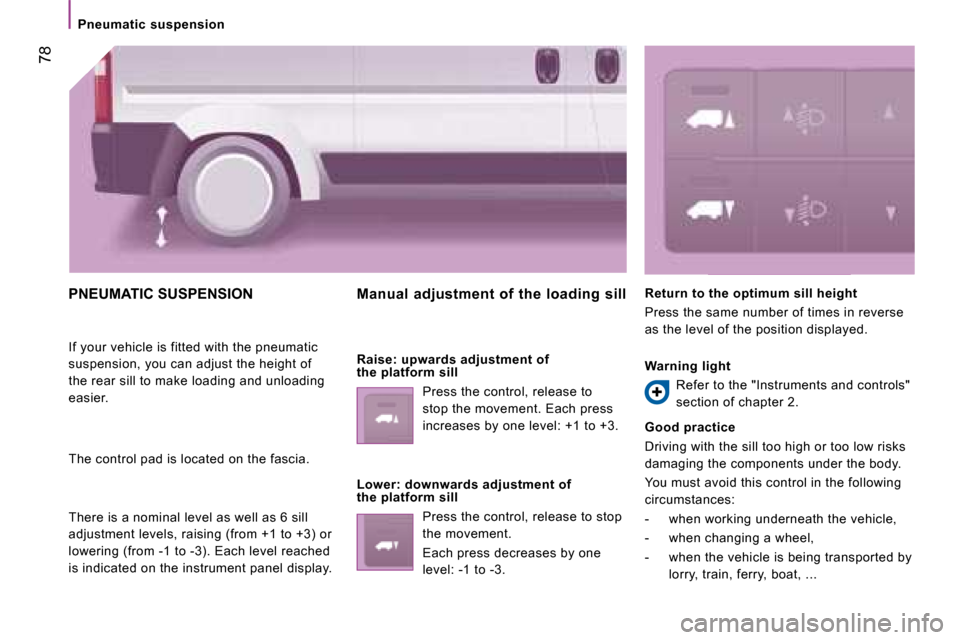
78
Pneumatic suspension
PNEUMATIC SUSPENSION
If your vehicle is fitted with the pneumatic
suspension, you can adjust the height of
the rear sill to make loading and unloading
easier.
The control pad is located on the fascia.
There is a nominal level as well as 6 sill
adjustment levels, raising (from +1 to +3) or
lowering (from -1 to -3). Each level reached
is indicated on the instrument panel display. Manual adjustment of the loading sill
Raise: upwards adjustment of
the platform sill
Press the control, release to
stop the movement. Each press
increases by one level: +1 to +3.
Lower: downwards adjustment of
the platform sill Press the control, release to stop
the movement.
Each press decreases by one
level: -1 to -3. Return to the optimum sill height
Press the same number of times in reverse
as the level of the position displayed.
Warning light
Refer to the "Instruments and controls"
section of chapter 2.
Good practice
Driving with the sill too high or too low risks
damaging the components under the body.
You must avoid this control in the following
circumstances:
- when working underneath the vehicle,
- when changing a wheel,
- when the vehicle is being transported by lorry, train, ferry, boat, ...
Page 98 of 163
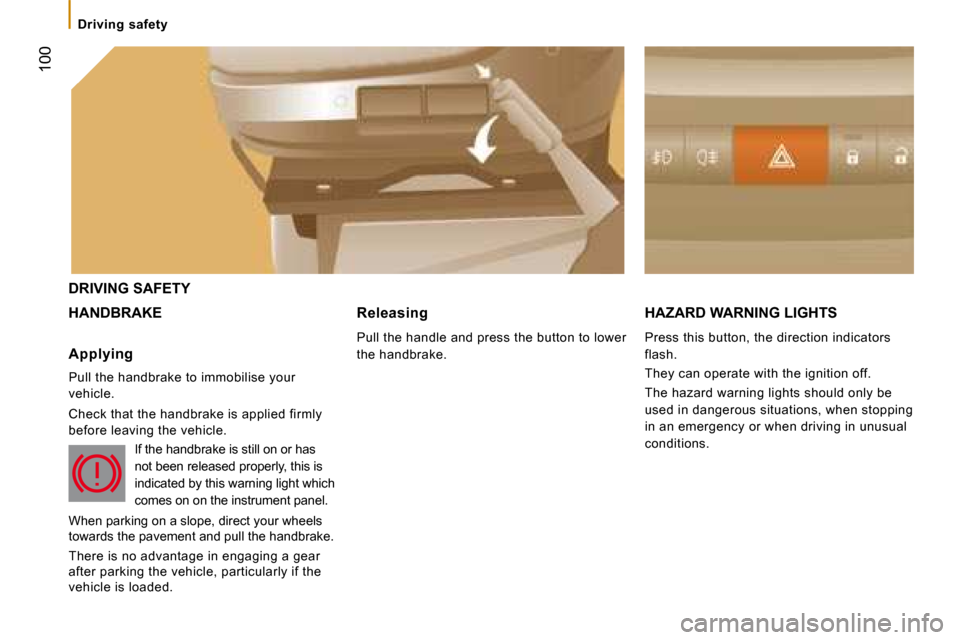
100
Driving safety
DRIVING SAFETY
HANDBRAKE HAZARD WARNING LIGHTS
Press this button, the direction indicators
flash.
They can operate with the ignition off.
The hazard warning lights should only be
used in dangerous situations, when stopping
in an emergency or when driving in unusual
conditions.
Applying
Pull the handbrake to immobilise your
vehicle.
Check that the handbrake is applied firmly
before leaving the vehicle.
If the handbrake is still on or has
not been released properly, this is
indicated by this warning light which
comes on on the instrument panel.
When parking on a slope, direct your wheels
towards the pavement and pull the handbrake.
There is no advantage in engaging a gear
after parking the vehicle, particularly if the
vehicle is loaded. Releasing
Pull the handle and press the button to lower
the handbrake.
Page 99 of 163
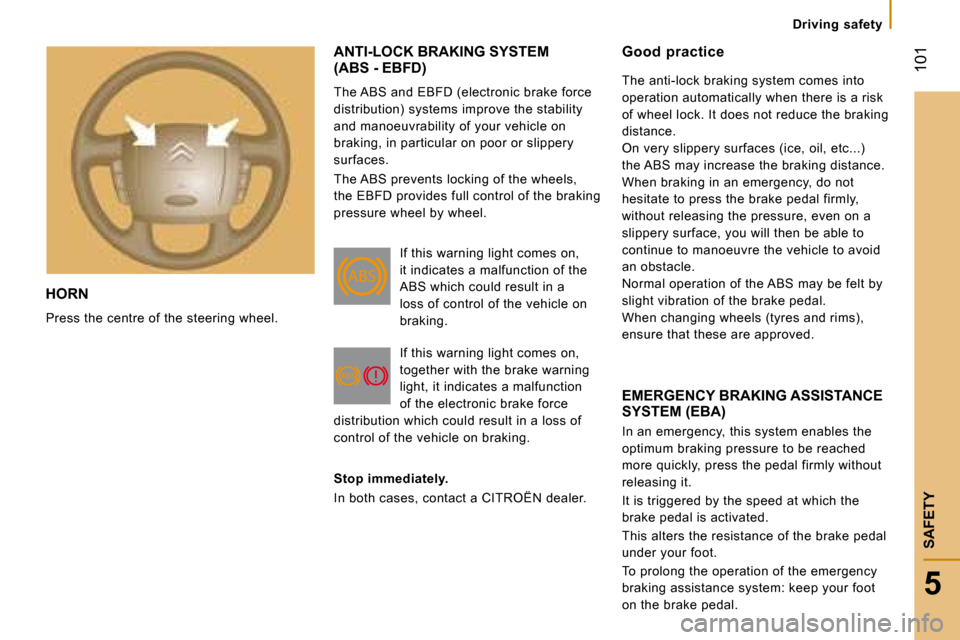
101
5
Driving safety
SAFETY
HORN
Press the centre of the steering wheel. ANTI-LOCK BRAKING SYSTEM
(ABS - EBFD)
The ABS and EBFD (electronic brake force
distribution) systems improve the stability
and manoeuvrability of your vehicle on
braking, in particular on poor or slippery
surfaces.
The ABS prevents locking of the wheels,
the EBFD provides full control of the braking
pressure wheel by wheel.
EMERGENCY BRAKING ASSISTANCE
SYSTEM (EBA)
In an emergency, this system enables the
optimum braking pressure to be reached
more quickly, press the pedal firmly without
releasing it.
It is triggered by the speed at which the
brake pedal is activated.
This alters the resistance of the brake pedal
under your foot.
To prolong the operation of the emergency
braking assistance system: keep your foot
on the brake pedal.
Good practice
The anti-lock braking system comes into
operation automatically when there is a risk
of wheel lock. It does not reduce the braking
distance.
On very slippery surfaces (ice, oil, etc...)
the ABS may increase the braking distance.
When braking in an emergency, do not
hesitate to press the brake pedal firmly,
without releasing the pressure, even on a
slippery surface, you will then be able to
continue to manoeuvre the vehicle to avoid
an obstacle.
Normal operation of the ABS may be felt by
slight vibration of the brake pedal.
When changing wheels (tyres and rims),
ensure that these are approved.
If this warning light comes on,
it indicates a malfunction of the
ABS which could result in a
loss of control of the vehicle on
braking.
If this warning light comes on,
together with the brake warning
light, it indicates a malfunction
of the electronic brake force
distribution which could result in a loss of
control of the vehicle on braking.
Stop immediately.
In both cases, contact a CITROËN dealer.
Page 100 of 163
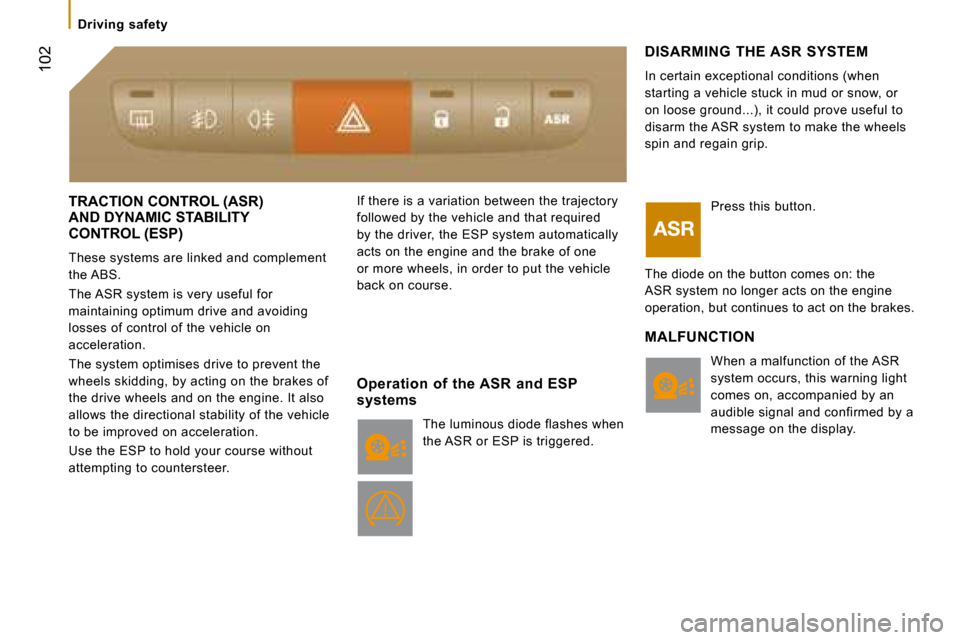
102
Driving safety
TRACTION CONTROL (ASR)
AND DYNAMIC STABILITY
CONTROL (ESP)
These systems are linked and complement
the ABS.
The ASR system is very useful for
maintaining optimum drive and avoiding
losses of control of the vehicle on
acceleration.
The system optimises drive to prevent the
wheels skidding, by acting on the brakes of
the drive wheels and on the engine. It also
allows the directional stability of the vehicle
to be improved on acceleration.
Use the ESP to hold your course without
attempting to countersteer. If there is a variation between the trajectory
followed by the vehicle and that required
by the driver, the ESP system automatically
acts on the engine and the brake of one
or more wheels, in order to put the vehicle
back on course.
DISARMING THE ASR SYSTEM
In certain exceptional conditions (when
starting a vehicle stuck in mud or snow, or
on loose ground...), it could prove useful to
disarm the ASR system to make the wheels
spin and regain grip.
Operation of the ASR and ESP
systems The luminous diode flashes when
the ASR or ESP is triggered. Press this button.
The diode on the button comes on: the
ASR system no longer acts on the engine
operation, but continues to act on the brakes.
MALFUNCTION When a malfunction of the ASR
system occurs, this warning light
comes on, accompanied by an
audible signal and confirmed by a
message on the display.
Page 101 of 163

5
Driving safety
SAFETY
FIXED SPEED LIMITER
If your vehicle is fitted with this function,
the speed of your vehicle can be limited
to a fixed speed of approximately 55 mph
(90 km/h) or 60 mph (100 km/h). This
maximum speed cannot be changed.
A label in the passenger compartment
indicates this maximum speed.
The fixed speed limiter is not a function
of the cruise control type. It cannot be
activated or deactivated by the driver while
driving.
When a malfunction of the ESP
system occurs, this warning light
comes on, accompanied by an
audible signal and confirmed by a
message on the display.
Contact a CITROËN dealer to have the
system checked.
Good practice
The ASR/ESP systems offer increased
safety during normal driving, but should not
incite the driver to take risks or to drive at
high speed.
The operation of these systems is ensured
if the recommendations of the manufacturer
regarding the wheels (tyres and rims),
the braking components, the electronic
components and the fitting and repair
procedures within the CITROËN network are
observed.
After an impact, have these systems
checked by a CITROËN dealer.
Page 102 of 163
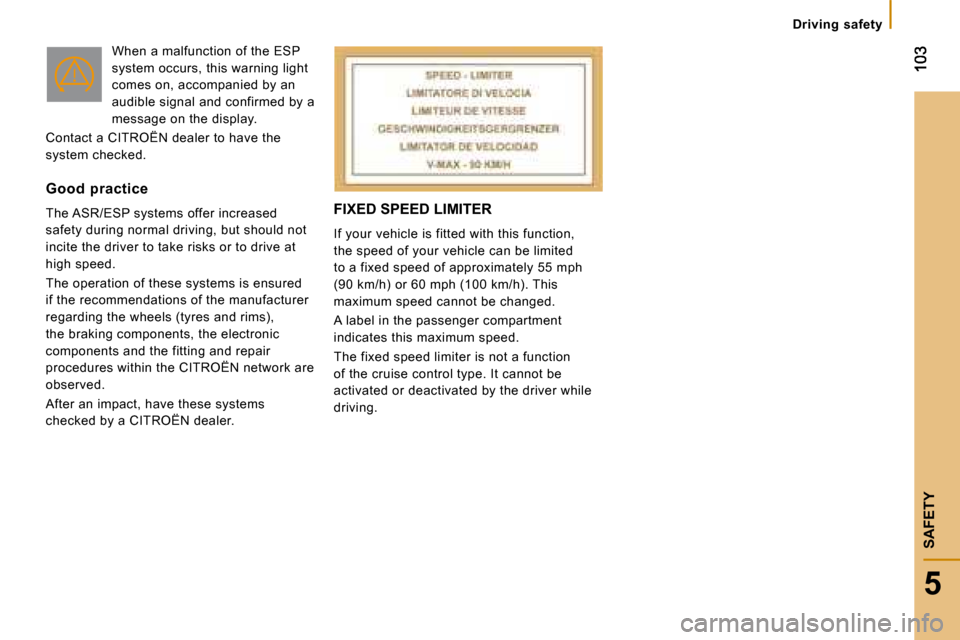
5
Driving safety
SAFETY
FIXED SPEED LIMITER
If your vehicle is fitted with this function,
the speed of your vehicle can be limited
to a fixed speed of approximately 55 mph
(90 km/h) or 60 mph (100 km/h). This
maximum speed cannot be changed.
A label in the passenger compartment
indicates this maximum speed.
The fixed speed limiter is not a function
of the cruise control type. It cannot be
activated or deactivated by the driver while
driving.
When a malfunction of the ESP
system occurs, this warning light
comes on, accompanied by an
audible signal and confirmed by a
message on the display.
Contact a CITROËN dealer to have the
system checked.
Good practice
The ASR/ESP systems offer increased
safety during normal driving, but should not
incite the driver to take risks or to drive at
high speed.
The operation of these systems is ensured
if the recommendations of the manufacturer
regarding the wheels (tyres and rims),
the braking components, the electronic
components and the fitting and repair
procedures within the CITROËN network are
observed.
After an impact, have these systems
checked by a CITROËN dealer.
Page 106 of 163
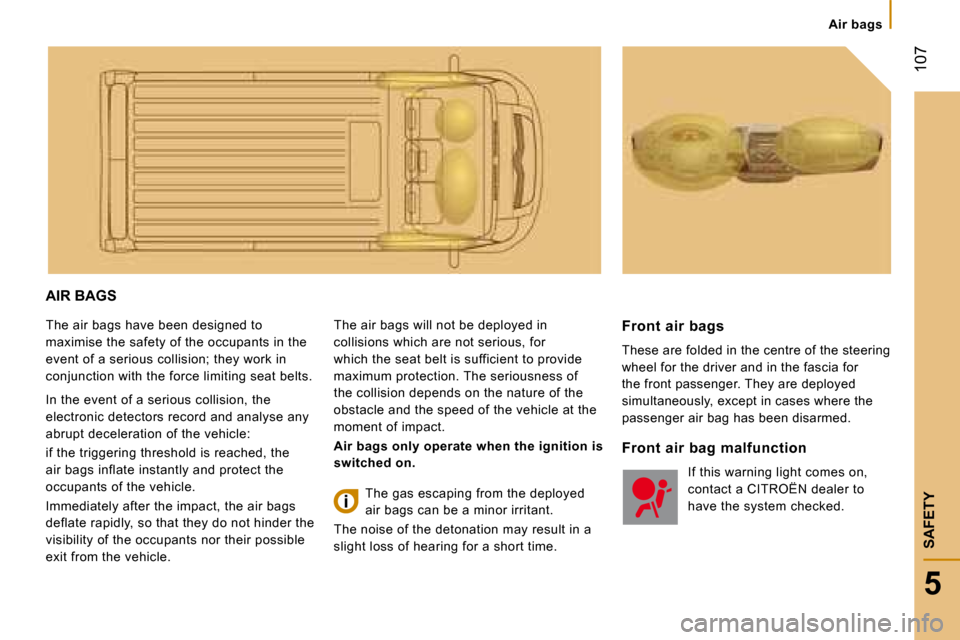
107
5
SAFETY
Air bags
AIR BAGS
The air bags have been designed to
maximise the safety of the occupants in the
event of a serious collision; they work in
conjunction with the force limiting seat belts.
In the event of a serious collision, the
electronic detectors record and analyse any
abrupt deceleration of the vehicle:
if the triggering threshold is reached, the
air bags inflate instantly and protect the
occupants of the vehicle.
Immediately after the impact, the air bags
deflate rapidly, so that they do not hinder the
visibility of the occupants nor their possible
exit from the vehicle. The air bags will not be deployed in
collisions which are not serious, for
which the seat belt is sufficient to provide
maximum protection. The seriousness of
the collision depends on the nature of the
obstacle and the speed of the vehicle at the
moment of impact.
Air bags only operate when the ignition is
switched on. Front air bags
These are folded in the centre of the steering
wheel for the driver and in the fascia for
the front passenger. They are deployed
simultaneously, except in cases where the
passenger air bag has been disarmed.
The gas escaping from the deployed
air bags can be a minor irritant.
The noise of the detonation may result in a
slight loss of hearing for a short time. Front air bag malfunction
If this warning light comes on,
contact a CITROËN dealer to
have the system checked.
Page 108 of 163

109
5
SAFETY
Air bags
Good practice
If your vehicle is fitted with front, side
and curtain air bags, in order for these to
be fully effective, observe the following
safety rules:
Wear a correctly adjusted seat belt.
Sit in a normal upright position.
Do not leave anything between the
occupants and the air bags (child, animal,
object...).
This could hamper the operation of the air
bags or injure the occupants.
All work on the air bag systems is strictly
prohibited unless it is carried out by qualified
personnel of the CITROËN network.
After an accident or if the vehicle has been
stolen or broken into, have the air bag
systems checked. Front air bags
Do not drive holding the steering wheel
by its spokes or resting your hands on the
centre part of the wheel.
Passengers must not place their feet on the
fascia.
Smoke as little as possible; deployment of
the air bags can cause burns or the risk of
injury from a cigarette or pipe.
Never remove or pierce the steering wheel
or hit it violently.
Side air bags
Only put approved covers on the front seats.
Consult a CITROËN dealer.
Do not fix or glue anything to the front seat
backs. This could cause injury to the chest
or arms when the side air bag is deployed.
Do not sit with the upper part of the body
any nearer to the door than necessary. Curtain air bags
Do not fix or glue anything to the pillars or
the roof. This could cause injury to the head
when the curtain air bag is deployed.
Do not remove the bolts from the grab
handles installed on the roof, they play a
part in securing the curtain air bags.